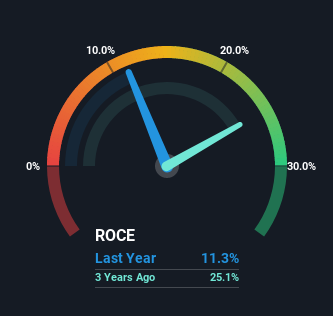- Canada
- /
- Healthcare Services
- /
- TSX:VMD
Some Investors May Be Worried About Viemed Healthcare's (TSE:VMD) Returns On Capital
To find a multi-bagger stock, what are the underlying trends we should look for in a business? One common approach is to try and find a company with returns on capital employed (ROCE) that are increasing, in conjunction with a growing amount of capital employed. This shows us that it's a compounding machine, able to continually reinvest its earnings back into the business and generate higher returns. In light of that, when we looked at Viemed Healthcare (TSE:VMD) and its ROCE trend, we weren't exactly thrilled.
Understanding Return On Capital Employed (ROCE)
For those that aren't sure what ROCE is, it measures the amount of pre-tax profits a company can generate from the capital employed in its business. To calculate this metric for Viemed Healthcare, this is the formula:
Return on Capital Employed = Earnings Before Interest and Tax (EBIT) ÷ (Total Assets - Current Liabilities)
0.11 = US$11m ÷ (US$119m - US$18m) (Based on the trailing twelve months to March 2022).
So, Viemed Healthcare has an ROCE of 11%. On its own, that's a standard return, however it's much better than the 7.2% generated by the Healthcare industry.
View our latest analysis for Viemed Healthcare

Above you can see how the current ROCE for Viemed Healthcare compares to its prior returns on capital, but there's only so much you can tell from the past. If you'd like, you can check out the forecasts from the analysts covering Viemed Healthcare here for free.
So How Is Viemed Healthcare's ROCE Trending?
When we looked at the ROCE trend at Viemed Healthcare, we didn't gain much confidence. To be more specific, ROCE has fallen from 21% over the last five years. And considering revenue has dropped while employing more capital, we'd be cautious. If this were to continue, you might be looking at a company that is trying to reinvest for growth but is actually losing market share since sales haven't increased.
On a side note, Viemed Healthcare has done well to pay down its current liabilities to 15% of total assets. So we could link some of this to the decrease in ROCE. What's more, this can reduce some aspects of risk to the business because now the company's suppliers or short-term creditors are funding less of its operations. Since the business is basically funding more of its operations with it's own money, you could argue this has made the business less efficient at generating ROCE.
The Bottom Line
In summary, we're somewhat concerned by Viemed Healthcare's diminishing returns on increasing amounts of capital. It should come as no surprise then that the stock has fallen 15% over the last three years, so it looks like investors are recognizing these changes. That being the case, unless the underlying trends revert to a more positive trajectory, we'd consider looking elsewhere.
One more thing to note, we've identified 2 warning signs with Viemed Healthcare and understanding these should be part of your investment process.
While Viemed Healthcare isn't earning the highest return, check out this free list of companies that are earning high returns on equity with solid balance sheets.
New: Manage All Your Stock Portfolios in One Place
We've created the ultimate portfolio companion for stock investors, and it's free.
• Connect an unlimited number of Portfolios and see your total in one currency
• Be alerted to new Warning Signs or Risks via email or mobile
• Track the Fair Value of your stocks
Have feedback on this article? Concerned about the content? Get in touch with us directly. Alternatively, email editorial-team (at) simplywallst.com.
This article by Simply Wall St is general in nature. We provide commentary based on historical data and analyst forecasts only using an unbiased methodology and our articles are not intended to be financial advice. It does not constitute a recommendation to buy or sell any stock, and does not take account of your objectives, or your financial situation. We aim to bring you long-term focused analysis driven by fundamental data. Note that our analysis may not factor in the latest price-sensitive company announcements or qualitative material. Simply Wall St has no position in any stocks mentioned.
About TSX:VMD
Viemed Healthcare
Through its subsidiaries, provides home medical equipment (HME) and post-acute respiratory healthcare services in the United States.
Excellent balance sheet and good value.
Similar Companies
Market Insights
Community Narratives



